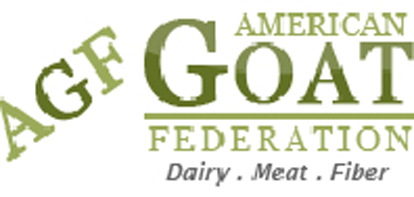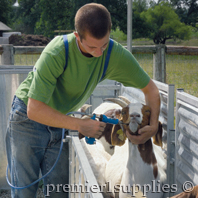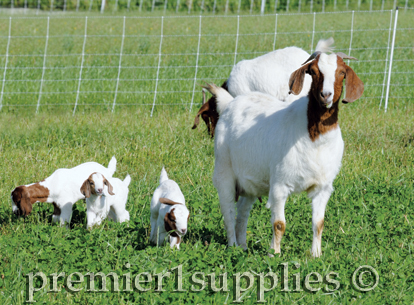BECOME A MEMBER
 American Goat Federation
American Goat Federation
The American Goat Federation was created specifically to represent, unify, improve and advance the American goat industry and assist producers to achieve maximum success.
The American Goat Federation (AGF) seeks to actively represent the interests of more than 150 organizations and thousands of producers engaged in the sustainable production and marketing of goat milk, meat, fiber, breeding stock and grazing services across the United States.
About Us
The American Goat Federation promotes and facilitates the development of all segments of the goat industry including dairy, meat and fiber, by encouraging sound public policy, enhancing production and marketing of goat products, and promoting research beneficial to our member organizations and all producers.
TREATMENTS
 Premier's preferred footrot treatments
Premier's preferred footrot treatments
FootCure™
FootCure is a traditional formula popular for topical application to animal feet. Proven antibacterial agents in a moisturizing base. Use with our SureFlexx™ Bandage Wrap or MediBoot.
Premier FootCare™
Specially formulated for the prevention and treatment of footrot and foot scald in goats.
Kopertox™
Effective and quick. But it corrodes metal gates (even nails and screws in wooden gates). So we use it for only topical treatments because there is no splashing.
View all of Premier's Foot Trimming & Care products.
DRENCHING TIPS

In the photo above we are using our Phillips™ auto drench gun. Comes complete with a backpack design, which is greatly appreciated after just one use.
Drenching for internal parasites
At Premier we deworm by drenching instead of injecting because it is:
| • |
Safer. Less risk if an animal receives too much drench. (Some injectable dewormers, if overdosed, will send animals into shock.)
|
| • |
More effective. Experts suggest that it kills a higher % of the parasites.
|
| • |
Assures a better pelt and carcass. Vaccinations can damage both.
|
| • |
Safer for the operator. No risk of sticking a needle into your hand.
|
"White" dewormers we suggest using are Safe-Guard® and Valbazen®. Both dewormers are approved for treating goats. When drenching, we prefer to use the Phillips™ Auto Drench Gun. Our herds are large and this makes a tedious task much easier. For small herds, the Small Flock Drencher and the Auto Syringe/Drenchers are effective. Always make sure to thoroughly clean the drencher after each use.
See all of Premier's Drenching & Vaccinating Products.
|
 |
 |

A common phrase when fencing goats: "If you can pour water through it, a goat will go through it." Properly electrified ElectroNet® (ElectroNet® Plus 9/35/12 shown in photo above) and ElectroStop® may not be watertight, but they can certainly be goat-tight.
Goat Health Management
It's a good time of year to be a haemonchus contortus or D. nodosus. The days are warm, the grass growth explosive and the goats are on pasture.
For folks interested in managing against footrot or worm infestations, the folks from Iowa State University, Purdue University, University of Maryland and University of Kentucky have kindly shared a few tips and hints.
|
VIP ARTICLE
Footrot in Sheep and Goats
By Lynn Pezzanite, Animal Sciences Student; Dr. Mike Neary, Small Ruminant Extension Specialist, Purdue University; and Terry Hutchens, Extension Goat Specialist, University of Kentucky
Footrot is a costly disease in the sheep and goat industry. Countless producers lose time and money each year in an attempt to control it in their flock or herd. If footrot becomes a problem, it takes much effort and labor to control symptoms and eliminate it. However, footrot is a preventable disease with attentive management.
Causes of Footrot
Footrot is caused by the coexistence of two gram-negative, anaerobic bacteria, Fusobacterium necrophorum and Dichelobacter nodosus (also referred to as Bacteroides nodosus). Several different strains of D. nodosus affect both sheep and goats, and can also be carried by cattle, deer, and horses. In general, sheep are affected more severely than goats.
Read More »
|
EXTENSION NEWS
Smart Use of Goat Dewormer
By eXtension Goats Community of Practice
"Smart Drench"
The most important aspect of using dewormers is to conserve their effectiveness for use in animals that truly need them. This can be achieved by using them as little as possible and only when infection levels dictate that intervention is necessary. The old concepts of treating all animals when only a few show signs, or all animals at regular intervals—shorter than every three to four months—is no longer warranted because it promotes dewormer resistance. Even if new dewormers are eventually discovered and marketed, they should not be used indiscriminately because that is how the current dewormer-resistance problem evolved.
It would be prudent to establish which dewormers are effective against a worm population on a given premises. This can be achieved by conducting fecal egg count (FEC) reduction testing and should be done by a qualified professional such as a veterinarian, laboratory technician, diagnostic laboratory, etc. FECs are not hard to do, but a microscope is required. The procedures for conducting a FEC are available online (see below). The concept is to do FEC before and 10 to 14 days after deworming treatment. If FECs after treatment are zero, the dewormer is very effective. Any FEC reduction below 95 percent calls a dewormer's effectiveness into question. The most effective dewomer on a given premises should be used only when no other treatment or management options are available, thus extending its useful life on that premises. FEC reduction testing may seem expensive, but it is worth the effort and expense to know what medications are effective on a particular farm. After the most effective dewormer has been selected, it must be used wisely.
Some aspects of "smart deworming" include these actions:
| • |
Do not use the most effective dewormer exclusively unless it is the only dewormer that works. Reserve its use for deworming those animals that need it the most and use less effective dewormers otherwise, if at all.
|
| • |
If rotating dewormers is necessary, do so at yearly intervals and rotate between classes of dewormers. Use the most effective dewormer in each class of dewormers.
|
| • |
Only deworm those animals that need to be dewormed, not the whole herd. As a general rule, a minority of the population harbors the majority of the worm population; thus, most of the animals may not need deworming. By following this process, much of the worm population is not exposed to the dewormer, and development of resistance can be slowed substantially. This is where the FAMACHA© monitoring system comes into play.
|
| • |
If there is substantial resistance to all dewormers tested, increasing the dosage or using combinations from different classes (such as levamisole and albendazole) may help; such extra-label use must be made in consultation with a licensed veterinarian and within the confines of a valid veterinarian-client-patient relationship. Another practice that may improve effectiveness is to take animals off feed for 24 hours before administering dewormer. This reduces rumen motility and dewormers pass through the gut more slowly and have more contact time with parasites. Never hold pregnant animals off feed, however.
|
| • |
Administer the proper amount of dewormer based on accurate body weights of animals to be treated. Confirm accurate administration of oral doses to the back of the animal's oral cavity.
|
| • |
Do not deworm and move to clean pasture for at least three months because worms that survive deworming are probably resistant to that dewormer. The new pasture will become contaminated with eggs/larvae of resistant worms.
|
For more information visit: Iowa State University Extension and Outreach
|
SHEEP 101
Available anthelmintics
By Susan Schoenian, Sheep 101
The link below is a table detailing the FDA-approved anthelmintics. Not all of the anthelmintics listed are labeled for goats. Check the FDA-approved species column (4th from left) to make sure it is safe to use with goats.
The list was compiled by Susan Schoenian. Susan is a Sheep & Goat Specialist at the University of Maryland’s Western Maryland Research & Education Center and an affiliated faculty member of the Department of Animal and Avian Sciences at the University of Maryland College Park. She is a certified Professional Animal Scientist. Susan has been with University of Maryland Extension (UME) since 1988. Previously, she served as Farm Management Specialist for Maryland’s nine Eastern Shore counties and as a county extension agent in Wicomico County. Her first professional job was as Sheep Specialist for the West Virginia Department of Agriculture. Susan earned her B.S. and M.S. degrees in Animal Science from Virginia Tech and Montana State University, respectively. She raises registered and commercial Katahdin sheep on a small farm called The Baalands in Clear Spring, Maryland.
Anthelmintic Table
|
|